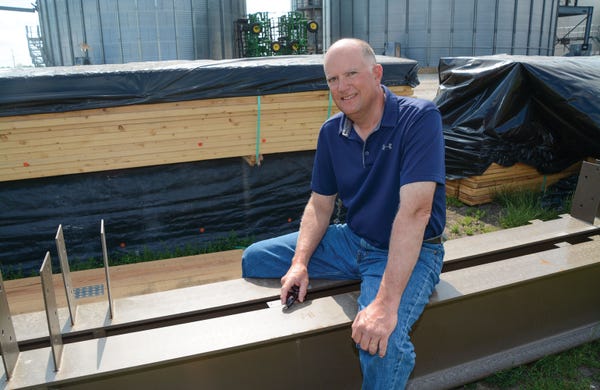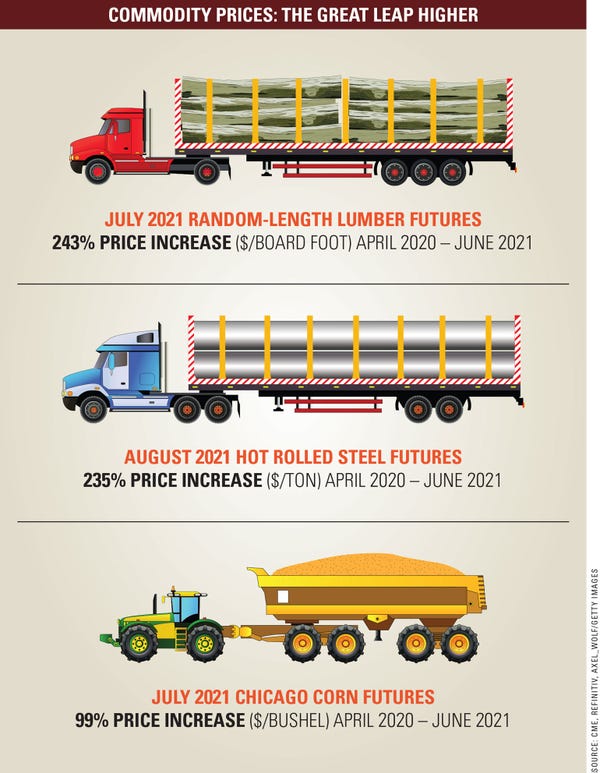
When South Dakota farmer Tom Davis started shopping for a new equipment shed, he was floored by the dealer’s quote.
“I originally heard it was going to be $65 per square foot. Then it went to $80 per square foot for a 100-by-160-foot building,” says Davis, who grows corn, soybeans and cattle with his brother Joe near Brookings.
“Here, concrete is $110 per cubic yard, and a lot of places it’s $130 to $140 per cubic yard. The price of the shop was approaching $600,000, and I just couldn’t see pulling the trigger at that price,” he says. “Rolled steel for roofing is hard to get, and lumber prices have quadrupled since COVID started.”

Like so many farmers, Davis is frustrated. With high commodity prices bringing in more revenue, farms are finally in a position to make needed expansion and upgrades to bins and buildings. But prices for steel and lumber are giving folks second thoughts.
As of June, new bins and buildings cost 30% to 40% more than a year earlier. In a May earnings call with analysts, bin-building company AGI reported farm backlog was up 75% over the prior year as of March 31. While lumber prices began to drop by mid-June, prices were still historically above-average.
Marc Padrutt, who farms just outside of Decatur, Ill., signed a contract for a new 80-by-120-foot equipment shed with Morton Buildings in February.
“I think I beat most of the price increase,” Padrutt says. “I talked to my dealer in late May and he said the same building today with electrical, in-floor heat, overhead doors, etc., would cost 20% to 25% more.”
Padrutt got delivery of the building components in June.

Davis, who also needs a bigger off-season space to work on crop equipment, will wait on a new equipment shed until 2022 or even 2023, and then reevaluate.
“I’m hoping lumber prices will come down and bring the cost of the building down with it,” he says. “I’m willing to be patient.”
Supply chain ripples
Over the last 16 months, COVID-19 transformed the way Americans spent money, and eventually, those changes rippled into every industry — including agriculture. The supply chain shocks coupled with government stimulus spending created a perfect inflationary storm resulting in today’s higher prices for grain bins, farm buildings and pretty much everything else related to farming.
When lockdowns began in March 2020, consumer spending on food deliveries, grocery stores and online retail spiked, while travel and restaurant sales tanked. Some consumers lost jobs, and as a result, the government began to send relief checks. But for those who kept working mainly from home, bank accounts surged. Interest rates remained historically low, making home investments more affordable.
“People had time, extra cash and stimulus money, and they wanted to do something with it,” notes Blair Neihouser, vice president of sales at FBi Buildings, Remington, Ind.
Consumers began a massive home renovation crusade to build decks, fences and other backyard projects. Demand for lumber exploded; sales at big-box stores spiked. At the same time, demand for flat metal, the kind used by metal and steel pole barn builders and bin makers, spiked.
At pole barn building companies like FBi, orders in spring 2020 dropped temporarily, and then “flipped like a light switch,” Neihouser says. “By late summer and early fall, you couldn’t get treated lumber due to the big demand. We started having much higher sales, and that pace was sustained through Q1 of this year.”
In October 2019, futures prices for random-length lumber were about $363 per 1,000 board feet; as of early June, that price was up 317%, notes Mark Billstrom, president at Lester Building Systems LLC. “In my eight years at Lester, this is unheard of,” he says. But demand — so far — trumps price in this market.
“If a client really wants a building, they are not going to go without,” he says. “They will find a way to pay for it. Right now, money is still cheap.”
Billstrom says his company was down 5% to 10% capacity over the course of the last year, as it guardedly followed COVID-19 protocols. It is now focusing on getting workers back into offices.
“We were very cautious,” Billstrom says. “We couldn’t afford to have a facility go down, so people with symptoms had to stay home.”
The situation was worse in sawmills, forced to cut output due to strict worker quarantine policies. “Some plants were down altogether for 14 days at a time,” he says.
Canada reduced exports to the U.S., not only due to the pandemic but also as part of an ongoing trade dispute.
“In sawmills and steel mills, for a couple weeks at a time, some portion of your labor force had to stay home, so of course that impacts how much you can produce,” Neihouser says. “Border crossing and labor availability really hurt supply capacity for both lumber and steel.
“With demand going through the roof at the same time supply was constricted, it was a perfect storm — and that skies the prices,” he says.
The story is similar for grain bins. South Dakota farmer Tom Davis ordered a new grain bin just before prices increased last fall and expects delivery in July. Another bin builder told him this spring that prices had gone up 21% since November, and that “they weren’t sure they would have the steel to get it done.”
Inflation triggers
As workers get vaccinated and return to the office, a big question remains: Will they go back to former spending habits?
“If they take the money they were spending on homes and shift it back to travel, that will put downward pressure on lumber prices,” notes Jason Henderson, ag economist at Purdue University. “But we could also see a permanent shift to stay-cations and home improvements. No one knows the answer yet. It all comes down to what consumers start doing now.”
And that could depend largely on interest rates. Federal Reserve Chairman Jerome Powell noted in March that the recovering economy would likely trigger inflation, but that it would be temporary, not long term. That’s an important distinction because long-term inflation could force the Fed to raise interest rates, as it has in the past to combat inflation.
In a MarketWatch interview, Boston Fed Reserve President Eric Rosengren said the inflation spike would be as temporary as the toilet paper shortage last year.
But inflation is also a result of monetary policy related to pandemic relief. “You have the federal government pushing out lots of money, and you have the Federal Reserve providing low interest rates,” Henderson notes. “That has sparked large expenditures in housing and equipment because you can lock in cheap rates for those durable assets.
“So, in addition to supply demand shifts, you have this monetary policy that puts a little lighter fluid on top of this phenomenal fire,” he adds. “Monetary tools are stimulating and sparking demand; that puts pressure on existing supplies and creates a real market phenomenon.”
Meanwhile, Davis will work out of his 1990-era equipment shed for at least another year.
“Machinery has gotten bigger, and we’re no longer able to get anything in there to work on it,” he says. “In the wintertime when we most need the shop for downtime repairs, we’re using all our heated buildings for livestock equipment.
“We need a bigger space to work on cropping equipment.”
Next in part two: What to consider before deciding on a new bin or building.
About the Author(s)
You May Also Like






